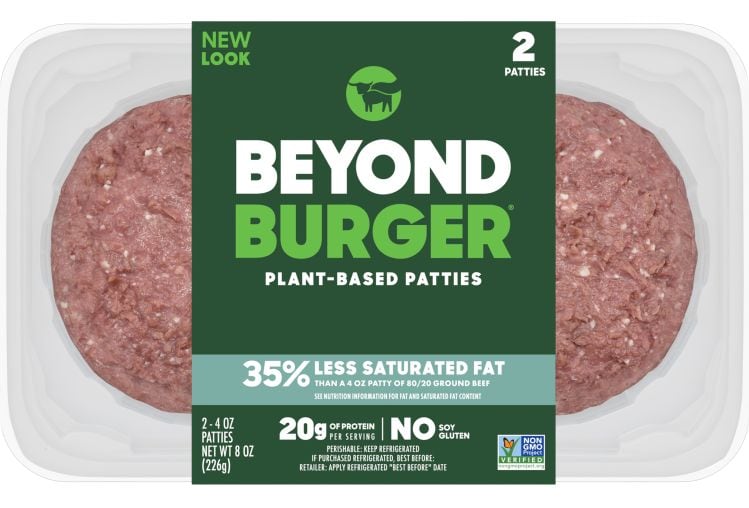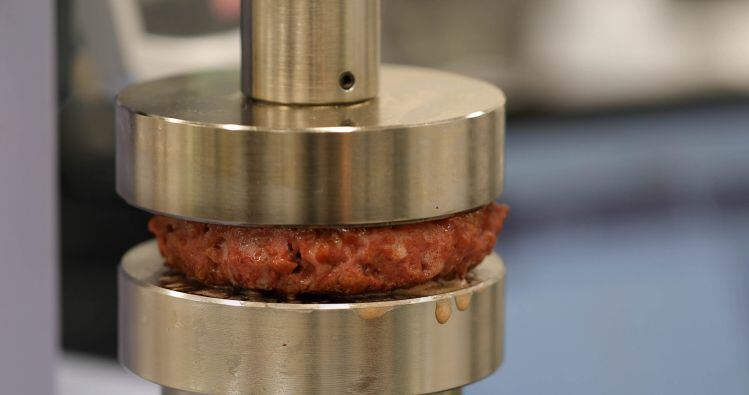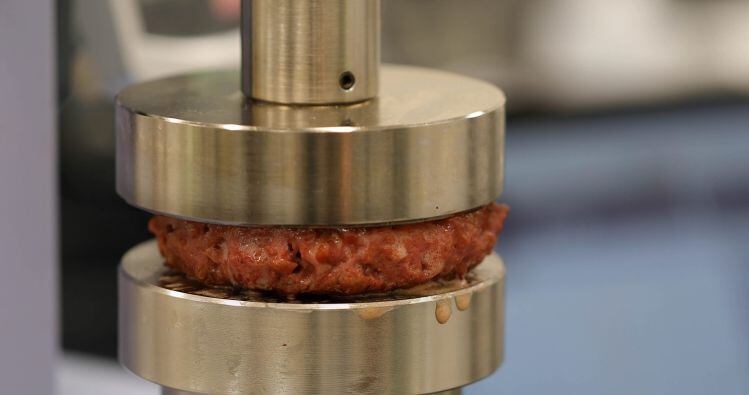According to US regulations (21 CFR 101.9(c)(7)), protein content (ie. total grams of protein per serving) must be listed on the Nutrition Facts panel, and “may be calculated on the basis of the factor 6.25x the nitrogen content of the food as determined by the appropriate method of analysis as given in the Official Methods of Analysis of the AOAC International.”
However, the percentage of the 50g daily value (%DV) for protein for brands also making front of pack protein claims is calculated by a different method (PDCAAS or Protein Digestibility Amino Acid Corrected Score), which ‘corrects’ or ‘adjusts’ the total protein figure based on the quality/digestibility of the protein.
This means that two brands which each have 20g total protein (calculated via nitrogen testing) could have different %DV figures if they use different protein sources with different PDCAAS scores (eg. rice protein vs casein).
Impossible Foods, as an example, lists the total protein in grams on its flagship soy protein-based burger as 19g. It lists the %DV as 31%, which implies that it has corrected/adjusted the protein content to reflect a PDCAAS of around 0.816 (were the PDCAAS score 1.0, it would list a %DV of 38% or 19g divided by 50g).
Beyond Meat lists the protein in its flagship pea and rice based burger as 20g, with a %DV of 40%, which suggests no PDCAAS adjustment/correction, and therefore a PDCAAS score of 1.0 or something very close to 1.0.
Plaintiff: 'Beyond Meat’s lower PDCAAS scores have caused Defendants to overstate the daily protein value on its flagship products'
According to a lawsuit filed last week by Beyond Meat’s former co-packer Don Lee Farms, independent testing found that the average PDCAAS score of the Beyond Burger, was slightly lower than 1.0, sitting at 0.8875.
If you ‘correct’ the protein score to reflect the PDCAAS of 0.8875, said Don Lee Farms, the %DV is in fact 35.49%, not 40%, as stated on the label.
While some commentators might argue that this isn't a very big deal, the discrepancy in other products is higher, claims Don Lee Farms, which says the protein %DV for Beyond Beefy Crumbles, for example, should be 20%, not 26%, as stated on the label, based on a PDCAAS of 0.645 determined by third party testing.
Beyond Meat has not addressed the specific claims in the lawsuit, but told this publication that the “allegations in the filing lack merit and we are prepared to vigorously fight this in court.”
'The adjusted protein amount is only used to calculate the % Daily Value for protein'
So is Beyond Meat’s label inaccurate, or is the 20g of protein listed on the label in fact an adjusted/PDCAAS corrected figure (suggesting total protein content of around 23g), which would mean consumers are, in fact, getting around 20g of digestible protein, which is 40% of the daily value?
And if so, is that approach to labeling permitted under the regulations?
Melissa Grzybowski, president at Food Consulting Company, would not comment on Beyond Meat’s labels or the litigation, but told us that her understanding of the regulations is that “the adjusted protein amount is only used to calculate the % Daily Value for protein.”
She added: “It's not a value that should be printed on the label in any other location. The actual protein value expressed in grams is always required on the Nutrition Facts Label and is the same value used when calling out the grams of protein elsewhere on the label [eg. on the front of the pack].”
FDA Q&A on protein nutrient content claims is 'confusing as written'
What has been an area of confusion, she said, is front of pack protein claims (eg. ‘20g protein per serving’), which have been the subject of some class action lawsuits in recent years, in which plaintiffs have tried to argue that firms should quote an adjusted/PDCAAS corrected figure on the front of pack in the interests of transparency as what matters to consumers is how much protein is actually digestible.
In January 2022, the FDA put out a Q&A that attempted to clear this issue up (see 'Label Claims' section near the bottom). This says firms should use an AOAC-approved nitrogen method for calculating grams of protein content on the Nutrition Facts panel, and the PDCAAS approach for %DV.
However, for front of pack protein claims, its says “Determination of compliance for protein nutrient content claims will be based on the use of the methods provided in 21 CFR 101.9(c)(7), including either of the methods mentioned above.”
This, says Grzybowski, is “confusing as written… I think FDA used a poor choice of words when they say ‘either of the methods.’ In my opinion, you are not allowed to adjust the gram amount of protein based on the PDCAAS. The regulations only allow the adjusted amount to be used in calculating %DV.”
Other legal sources pointed out that it would also be confusing to allow firms to use a 'corrected/adjusted' figure for grams on the front of pack, but a total (unadjusted) figure in grams on the Nutrition Facts panel on the back of the pack (as the two numbers would be different if the PDCAAS is less than 1.0).
'Protein claims and confusion of PDCAAS adjustment have been on a significant uptick over the past year'
Jesse Zuehlke, PhD, general manager at Prime Label Consultants, told FoodNavigator-USA he was also unable to comment on the Beyond Meat label or lawsuit, but noted that “Protein claims and confusion of PDCAAS adjustment have been on a significant uptick over the past year.”
Echoing Grzybowski, he added: “The PDCAAS correction only applies to calculating the %DV, never to the grams stated.”
However, in recent years, he said, “we have seen litigation on front of pack statements (eg. ‘10g protein per serving’) made on the basis that the gram statement is misleading because it was not corrected via PDCAAS. But the concept of using PDCAAS to correct a front of pack grams statement of protein is not at all drawn from FDA regulations, as far as I know it is completely invented by plaintiffs.
“The FDA addressed aspects of this earlier this year by adding a Q&A on an industry resource page clarifying that the PDCAAS score is used in calculating the %DV."
But he added: “It can be compliant to label a reduced number of grams of a nutrient vs. what is actually in the product. Here specifically one may consider protein to be a Class I nutrient, which removes the 80% / 120% leeway and often necessitates a buffer of ‘extra’ protein in the product.”
But he added: “I would expect this buffer to be applied to the %DV as well. It would be unconventional for a label to use PDCAAS to correct (reduce) both the grams statement and the %DV, however perhaps not truly noncompliant.”
Optimizing plant-based formulations to achieve higher PDCAAS scores
Lauren Swann, president at food and nutrition labeling consultant FoodFactsWork, said she is not able to comment on the accuracy of Beyond Meat's labels without knowing its formula, but added that it is possible to come up with combinations of plant proteins to reach a PDCAAS of 1, or something so close to 1.0 "that any PDCAAS adjustment could be negligible for the %DV."
Pea and rice is a widely used combination in this regard owing to their complementary amino acid profiles, she said, quoting from a review in the journal Nutrients: ‘Plant Proteins: Assessing Their Nutritional Quality and Effects on Health and Physical Function.
"Protein blends of pea and rice ranging 40–90% pea protein can achieve a PDCAAS of 1.00, using the 2011 FAO amino acid reference pattern for adults.”
How do firms calculate PDCAAS corrections?
Zuehlke added: "How to apply PDCAAS correction to a food and determine the percent daily value is a case-by-case question. For simple food matrices with well defined ingredients a calculation based on literature values is often appropriate. As the food becomes more complex the likelihood of interaction among individual proteins impacting the score increases.
"Best practice in complex foods - or when protein is an important aspect of branding - is usually going to at least consider lab analysis. The PDCAAS methods in 21 CFR reference a FAO/WHO Expert Consultation Report from 1991.
"FAO/WHO now actually recommend the DIAAS method for protein quality evaluation, this was considered but not updated during the recent FDA Nutrition Label Reform efforts."
Front of pack protein claims in the courts
According to a recent review of class action lawsuits filed vs food & beverage companies in 2021, law firm Perkins Coie noted that “several lawsuits were filed alleging that food companies overstated the amount of protein in their products by using a total protein figure [calculated via nitrogen testing] for a front-of-pack protein content claim, rather than a protein figure adjusted for digestibility.
Although plaintiffs saw initial success, said Perkins Coie, recent orders have “discredited plaintiffs’ theory and sounded a death knell on this highly technical claim.”
In a February 2022 order dismissing one such class action vs KIND Snacks (Chong v KIND LLC 3:21-cv-04528) filed in California, for example, Judge Seeborg said: “A correct reading of the regulations establishes that producers may state grams of protein even outside the Nutrition Facts panel [on the front of pack, for example] calculated by the nitrogen method, and without adjustment for digestibility.”
21 CFR 101.9(c)(7) does not explicitly spell out how companies should calculate protein content for purposes of a front-of-pack protein content claim, although Judge Seeborg may have come to his view about the ‘correct reading’ of the regulations after reading the Q&A issued by the FDA in January.




